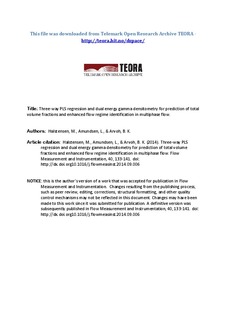3-way PLS regression and dual energy gamma densitometry for prediction of total volume fractions and enhanced flow regime identification in multiphase flow
Journal article, Peer reviewed
Accepted version
Permanent lenke
http://hdl.handle.net/11250/2438446Utgivelsesdato
2014-12Metadata
Vis full innførselSamlinger
Originalversjon
Halstensen, M., Amundsen, L., & Arvoh, B. K. (2014). Three-way PLS regression and dual energy gamma densitometry for prediction of total volume fractions and enhanced flow regime identification in multiphase flow. Flow Measurement and Instrumentation, 40, 133-141. doi: http://10.1016/j.flowmeasinst.2014.09.006 10.1016/j.flowmeasinst.2014.09.006Sammendrag
Dual energy gamma densitometry and 3-way partial least squares regression were applied to quantify the total volume fractions and improve flow regime identification in multiphase flow. Multiphase flow experiments were carried out with formation water, crude oil and gas from different North Sea gas fields in Statoil's High Pressure Multiphase Flow Loop in Porsgrunn, Norway. Four different flow regimes were investigated (stratified wavy, slug, dispersed and annular). A traversable dual energy gamma densitometer was used to measure the fluid densities in the pipe. Partial least squares regression was previously applied to identify multiphase flow regimes and quantify volume fractions of gas, oil and water. That study showed promising results for flow regime identification but the predictions of the total volume fractions were not acceptable. In this study a new method combining gamma densitometry and 3-way partial least squares regression was applied in order to improve the quantitative estimation of the total volume fractions gained the previous study. The proposed 3-way regression approach allows prediction of the total volume fractions directly using one model instead of multiple models which was reported earlier. The improved quantification of the volume fractions of gas, oil and water was used to improve the flow regime identification plots and increase the interpretability. The new 3-way prediction results for the volume fractions were significantly better than what was found earlier based on individual PLS models. The root mean square error of prediction for gas, oil and water from the 3-way PLS models were 4.1 %, 4.3 % and 4.6% respectively. All models reported were validated based on independent data (test set validation).
